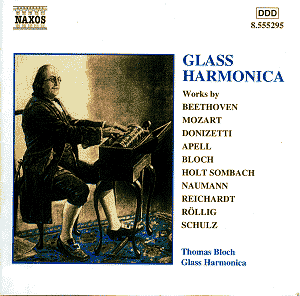Any temptation to classify this fascinating disc as
a musical curiosity is easily disposed of by a glance at track list.
It contains fourteen works , of which seven are world premiere recordings.
These range from the eighteenth to the twentieth century. In all of
them the glass harmonica features either as a solo instrument, or is
combined with voices or less unfamiliar instruments. But first the listener
needs to know what to expect.
The glass harmonica is one of many newly invented instruments
that appeared in the eighteenth and nineteenth centuries, most of which
quickly became obsolete. However, unlike its rivals it captured the
public imagination, and in the nineteenth century around four hundred
compositions had been written for it, including works by Mozart and
Beethoven. Invented in 1743 by an Irishman, Richard Puckeridge, and
later mechanised as a pedalled instrument by Benjamin Franklin, it relies
on a phenomenon well known to most schoolchildren: that a recognisably
musical sound can be produced by stroking a moistened finger around
the rim of an ordinary drinking glass. For this instrument bowl-shaped
glass discs of graduated sizes, each corresponding to a note in the
chromatic scale, are mounted on an axle and rotated by a pedal action.
After passing through a shallow water trough they are rotated by the
pedal, and when touched by the player’s fingers produce flute-like,
ethereal sounds, described by Paganini as "a celestial voice".
The instrument attracted many admirers, and in 1829 was considered "the
fashionable accessory of parlours and drawing rooms". However,
like so many novelties, it went out of fashion. This recording was made
on a modern reproduction by Gerhard Finkenbeiner.
Mozart was probably the only famous composer to take
the glass harmonica seriously enough to write several fairly extended
works for it though, as the contemporary pieces on this disc show, its
fascination has remained powerful enough to attract some present-day
players and composers. Thomas Bloch is unquestionably a virtuoso, with
all the skills necessary to fulfil the roles of soloist, accompanist
and ensemble player.
For the solo pieces a fairly low volume setting may
be necessary to appreciate the "celestial" quality attributed
to the glass harmonica. To my ears its crystalline voice can easily
become rather monotonous unless it is set against other instruments,
though with them – or with voices sympathetic to its timbre, as on this
record – the effect can be magical. Mozart is given a generous 19 minutes,
his cool elegance immediately recognisable. Beethoven’s accompaniment
to a sad spoken poem lasts a mere sixty seconds. The obvious delight
of (to me) unknown composers in exploring new sonorities is engagingly
displayed in many of the earlier pieces, and also those by von Holt
Sombach (b.1962) who unashamedly turns the clock back to a nineteenth
century style without indulging in pastiche, and to pleasant effect.
The brief aria from the mad scene in Donizetti’s Lucia di Lammermoor,
now invariably played on a flute, gains little from being restored
to its original scoring for glass harmonica. Thomas Bloch’s own Sancta
Maria (modestly placed on the final track) is a satisfying, intensely
dramatic setting in a decidedly – though not defiantly – atonal idiom
that fully establishes the instrument’s right to be seriously considered
among the "new sounds" that intrigue so many modern composers.
Unquestionably a disc for connoisseurs.
Thomas Bloch’s excellent essay on the history and repertoire
of the glass harmonica is included with the insert booklet, and well
worth reading. Both he and the maker of the instrument used for this
recording have web sites from which more detailed information is available.
Bloch’s is www.chez.com/thomasbloch
and Finkenbeiner’s is www.finkenbeiner.com.
Roy Brewer


![]() Thomas Bloch (glass
harmonica) with (as programmed) the Rosamunde Quartet; Marc Marder (double
bass); Philippe Bernold (flute), Maurice Bourgue (oboe), Jean Sulem (viola),
Xavier Gagnepain (cello); Fabrice Di Falco and Yves Le Pech (male sopranos),
Damien Top (tenor) and Christine Icart (harp); Montserrat Sanromà
(soprano) and Ettore Borri (piano); Fabrice Di Falco (male soprano, baritone
and all voice parts).
Thomas Bloch (glass
harmonica) with (as programmed) the Rosamunde Quartet; Marc Marder (double
bass); Philippe Bernold (flute), Maurice Bourgue (oboe), Jean Sulem (viola),
Xavier Gagnepain (cello); Fabrice Di Falco and Yves Le Pech (male sopranos),
Damien Top (tenor) and Christine Icart (harp); Montserrat Sanromà
(soprano) and Ettore Borri (piano); Fabrice Di Falco (male soprano, baritone
and all voice parts).![]() NAXOS 8.555295 [70.56]
NAXOS 8.555295 [70.56]